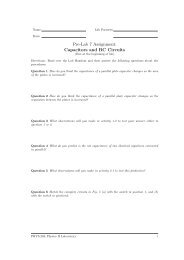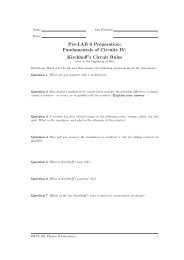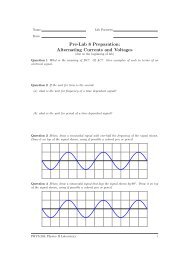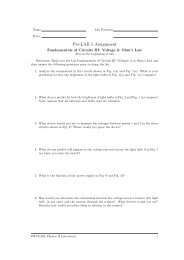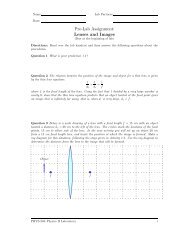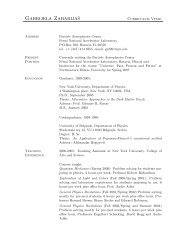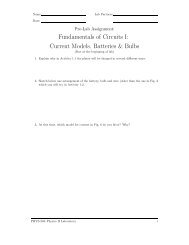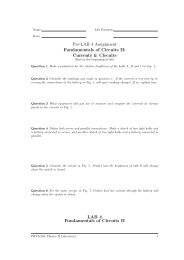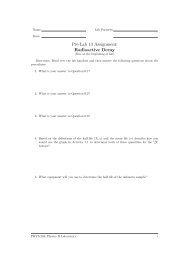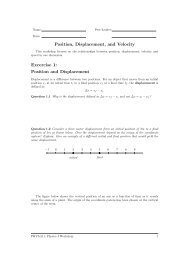College Physics 2 â Boot Camp Module 1 Name: Group Members:
College Physics 2 â Boot Camp Module 1 Name: Group Members:
College Physics 2 â Boot Camp Module 1 Name: Group Members:
You also want an ePaper? Increase the reach of your titles
YUMPU automatically turns print PDFs into web optimized ePapers that Google loves.
<strong>College</strong> <strong>Physics</strong> 2 – <strong>Boot</strong> <strong>Camp</strong><br />
<strong>Module</strong> 1<br />
<strong>Name</strong>: _________________________________________<br />
<strong>Group</strong> <strong>Members</strong>: ________________________________<br />
Electric Charge and Electric Fields<br />
In the figure below two 9g balls are hanging by threads that can support masses of up to<br />
10g. The threads are 10 cm long and are 10 cm appart.<br />
10 cm<br />
10 cm<br />
For the next few questions you are not required to perform any calculations and you are<br />
allowed to use the table above and the map below to subside your answers. Use<br />
complete sentences to justify your answers.<br />
1. Is it possible to break the trhread by electrically charging the balls Explain why or<br />
why not<br />
2. If charging the balls can break the thread would it make a difference if you are<br />
charging the balls with like or unlike charges Explain your reasoning. If necessary draw<br />
some diagrams to make your answer more clear.
<strong>College</strong> <strong>Physics</strong> 2 – <strong>Boot</strong> <strong>Camp</strong><br />
<strong>Module</strong> 1<br />
3. Calculate the maximum horizontal force one can apply without breaking the thread.<br />
4. Assume the force between the balls to be attractive. Calculate the maximum charge<br />
that the balls can hold without breaking the thread.
<strong>College</strong> <strong>Physics</strong> 2 – <strong>Boot</strong> <strong>Camp</strong><br />
<strong>Module</strong> 1<br />
5. Assume the force between the balls to be repulsive. Calculate the maximum charge<br />
that the balls can hold without breaking the thread.<br />
6. Do your answers to questions 4 and 5 agree with your answers to questions 1 and 2 If<br />
not, analyze your answers and determine the source of the disagreement.
<strong>College</strong> <strong>Physics</strong> 2 – <strong>Boot</strong> <strong>Camp</strong><br />
<strong>Module</strong> 1<br />
At each corner of a square of side l there are four point charges of magnitudes Q, and Q<br />
(figure below).<br />
l<br />
Q -Q<br />
l<br />
l<br />
-Q Q<br />
l<br />
1. Sketch the electric field lines due to this distribution of charge.<br />
2. Indicate in your sketch where the magnitude of the field is the strongest. Justify<br />
your answer.<br />
3. Is there anyplace in the sketch of question 1 where the electric field is zero.<br />
Justify your answer.
<strong>College</strong> <strong>Physics</strong> 2 – <strong>Boot</strong> <strong>Camp</strong><br />
<strong>Module</strong> 1<br />
Now consider the following arrangement of the same charges.<br />
l<br />
Q -Q<br />
l<br />
l<br />
Q -Q<br />
l<br />
4. Sketch the electric field lines due to this distribution of charge.<br />
5. Indicate in your sketch where the magnitude of the field is the strongest. Justify<br />
your answer.<br />
6. Is there any place in the sketch of question 1 where the electric field is zero.<br />
Justify your answer.
<strong>College</strong> <strong>Physics</strong> 2 – <strong>Boot</strong> <strong>Camp</strong><br />
<strong>Module</strong> 1<br />
Consider two point charges of magnitudes 1C and 2C arranged as in the figure<br />
below.<br />
A<br />
20 cm<br />
10 cm<br />
40 cm<br />
B<br />
1 C 2 C<br />
20 cm<br />
C<br />
D<br />
1) Determine the magnitude and direction of the electric field at point A, B, C, and D.<br />
Show your work or justify your answer.
<strong>College</strong> <strong>Physics</strong> 2 – <strong>Boot</strong> <strong>Camp</strong><br />
<strong>Module</strong> 1<br />
2) What will happen if you place a negative charge at point A Justify your answer.<br />
3) What will happen if you place a positive charge at point A Justify your answer.<br />
4) What will happen if you place a negative charge at point B Justify your answer.<br />
5) What will happen if you place a positive charge at point B Justify your answer.





